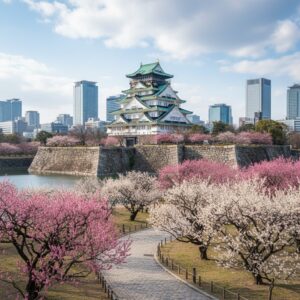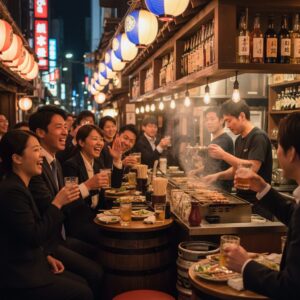Osaka, a city that pulses with a culinary heartbeat all its own, is a sprawling canvas of gastronomic delights. While districts like Namba and Shinsaibashi glitter with neon and draw crowds with their famous takoyaki stands and towering crab signs, there exists another, more granular Osaka. It’s a city tucked away in the creases of its own map, a place where time seems to flow a little differently. To find it, you must venture east of the city center to Kyobashi, a bustling transit hub that serves as a gateway to one of Japan’s most authentic and exhilarating cultural experiences: the old-school ‘tachinomi,’ or standing bar. This isn’t a world curated for tourists; it’s a living, breathing ecosystem of after-work rituals, quick bites, and communal cheer, a place where the soul of working-class Osaka is served up in small glasses and on sizzling skewers. Kyobashi’s tachinomi scene is more than just a collection of bars; it’s a portal to the Showa era, a raw, unfiltered immersion into a tradition that has fueled the city for generations. Here, under the soft glow of paper lanterns and the hum of railway lines, you don’t just eat and drink; you participate in a nightly symphony of local life, a rhythmic dance of clinking glasses and heartfelt conversations that offers a profound connection to the city’s unvarnished heart. For the traveler seeking a story to tell, one that resonates with the genuine cadence of everyday Japan, the labyrinthine alleys of Kyobashi await.
After immersing yourself in the vibrant local culture, consider exploring another iconic Osaka experience by visiting the stunning Osaka Castle and its beautiful seasonal gardens.
The Electric Gateway: Arriving in Kyobashi
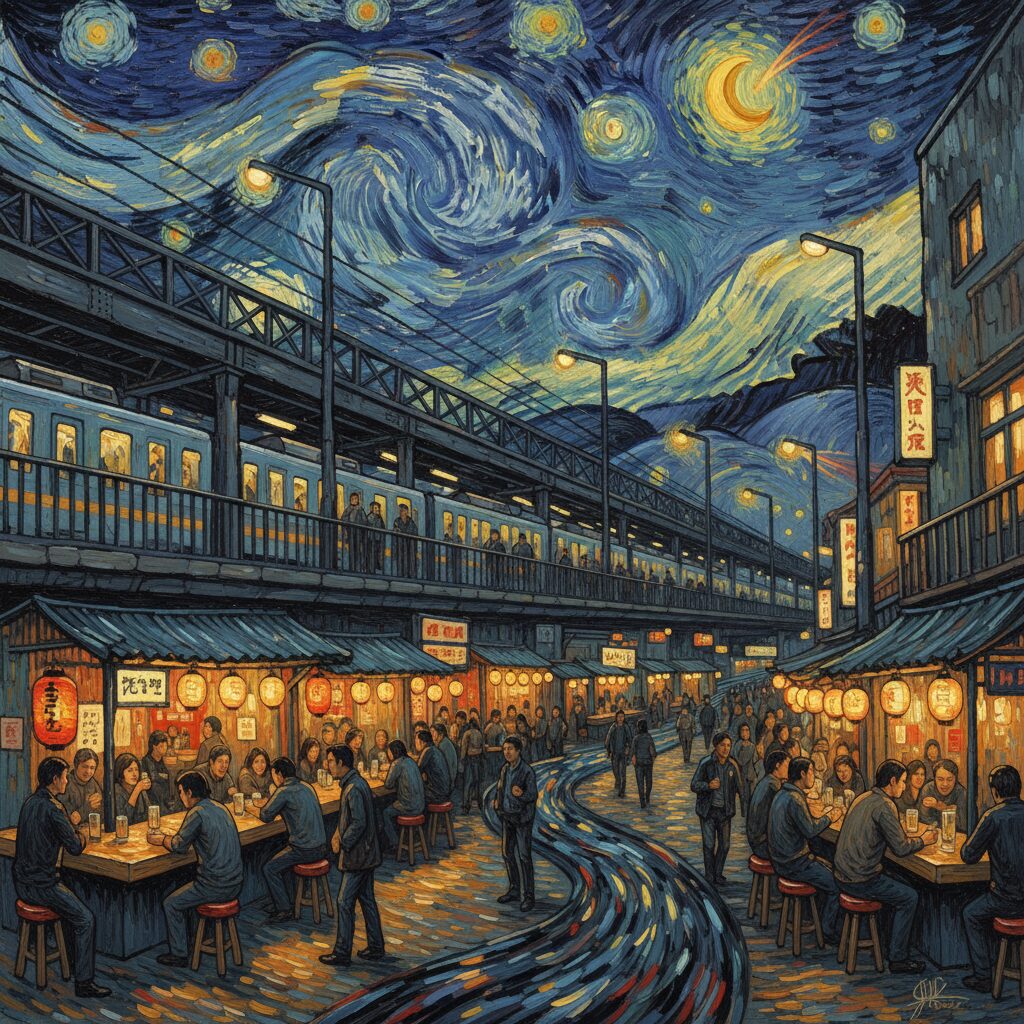
The moment you step off the train at Kyobashi Station, you sense a shift in the city’s energy. As a key junction where the JR Osaka Loop Line, the Katamachi Line, the Tozai Line, the Keihan Main Line, and the Nagahori Tsurumi-ryokuchi subway line all intersect, Kyobashi is perpetually in motion. It’s a place of arrivals and departures, a steady flow of people moving in and out to the rhythmic beat of the train schedules. Unlike the polished, expansive underground malls of Umeda or the theatrical streetscapes of Dotonbori, Kyobashi immediately feels more practical, more grounded. The air carries a distinctive mix, blending savory aromas from hidden kitchens with the faint, metallic scent of elevated train tracks. Look up, and you’ll see a complex mesh of concrete and steel, symbolizing Japan’s post-war infrastructure boom. Look down, and you’ll find a district that defies a single style. Sleek, modern office buildings stand side-by-side with weathered, low-rise shopping arcades, their facades narrating stories from decades past. This contrast defines Kyobashi. It’s a neighborhood that hasn’t been polished for international appeal. It wears its history openly, its grit a mark of pride. Reaching it is easy; from Osaka Station, a brief ride on the JR Loop Line brings you to its vibrant core. Its close proximity to landmarks like Osaka Castle offers a striking contrast: you can spend your afternoon appreciating the grandeur of feudal Japan before diving into the wonderfully chaotic and deeply personal atmosphere of its evening culture.
Diving into the Labyrinth: The Kyobashi Standing Bar Arcades
To truly grasp Kyobashi, you must step off the main streets and immerse yourself in its maze of covered ‘shotengai’ and narrow ‘yokocho.’ These alleys are the heart of the district’s tachinomi culture. As dusk falls, they undergo a change. The daytime bustle of grocers and shopkeepers fades into a warmer, more intimate murmur. Red paper lanterns, or ‘akachochin,’ flicker outside tiny doorways, each one a beacon welcoming warmth, camaraderie, and affordable, delicious food. The air thickens with the enticing aroma of grilled meat, simmering dashi broth, and the subtle sweetness of sake. This sensory overload is magnificent in every way. Peeking inside reveals a world compressed into just a few square meters—no tables or chairs, only a long wooden counter, polished smooth and dark from years of countless elbows. The walls are often a chaotic mix of handwritten menus, yellowed posters, and calendars from local sake breweries. The space is tight, intimate, and utterly unpretentious. Patrons stand shoulder to shoulder, representing a diverse cross-section of Osaka society: salarymen loosening ties after a long day, elderly couples sharing a quiet drink, young friends catching up over sizzling skewers. The atmosphere is not just welcoming; it’s communal. There is an unspoken understanding that in this small space, everyone becomes part of the same temporary family. This is a living museum of Showa-era Japan, a time of immense economic growth and social change. These bars arose from a need for affordable, efficient places where the working class could unwind. They remain essential third spaces, serving as community centers where stories are shared, friendships are made, and the day’s stresses are eased with a cold beer and a hot meal. To enter a Kyobashi tachinomi is to step into living history, a place where tradition is not just preserved but actively lived each and every night.
A Symphony of Sips and Bites: Mastering the Tachinomi Menu
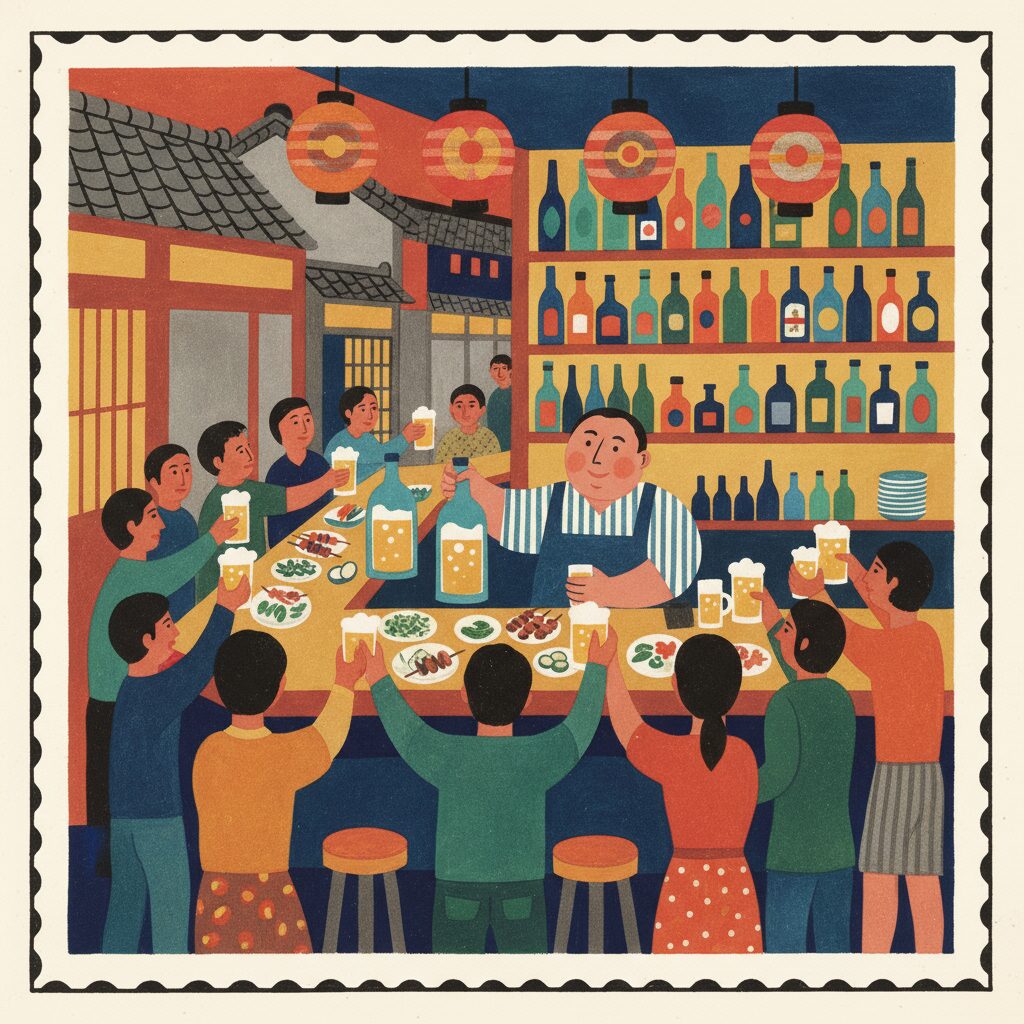
The charm of the tachinomi experience rests in its graceful simplicity and deep richness. The offerings are crafted for quick enjoyment, yet made with a care and precision that reflects Japan’s culinary spirit. Exploring the menu, often handwritten on strips of paper and posted on the wall, adds to the excitement.
The Libations
Your adventure will probably start with a drink. The undisputed favorite is ‘nama biru,’ a crisp, cold draft beer typically served in a heavy, frosted mug. It’s the ideal refreshment to cut through the humidity of an Osaka summer or to cleanse the palate between bites. Just as popular is the highball, a straightforward yet exquisite mix of Japanese whisky and super-carbonated soda water over ice. It’s light, refreshing, and surprisingly easy to drink. Then there’s the ‘chuhai,’ a shochu-based highball available in a spectrum of flavors, from classic lemon and lime to more daring options like grapefruit or calamansi. And naturally, there is sake. Don’t feel overwhelmed by the choices. Many tachinomi offer ‘kappu-zake,’ single-serving glasses of sake, which is a great way to sample different kinds. You might also encounter terms like ‘atsukan’ (hot sake) or ‘hiya’ (chilled sake). On a cold evening, a flask of atsukan feels like a warm hug, its gentle heat spreading with every sip. The staff are usually more than willing to suggest something if you simply point and ask for ‘osusume’ (recommendation).
The Cuisine
What truly transforms the tachinomi from just a bar into a culinary destination is the food, known as ‘ate’ or ‘tsumami.’ These are not full meals but small, flavorful dishes meant to accompany alcohol. The range is impressive, and each bar has its own specialties.
Kushikatsu
A classic Osaka treat, ‘kushikatsu’ consists of skewers of meat, seafood, and vegetables, breaded with fine panko crumbs and deep-fried until golden. You’ll find everything from pork loin (‘tonkatsu’) and chicken thigh (‘momo’) to lotus root (‘renkon’), shiitake mushrooms, and even cheese. They’re served with a communal pot of thin, savory dipping sauce. This is where the most sacred rule of Osaka dining applies: no double-dipping! Once a skewer has touched your lips, it must never be returned to the sauce pot. This etiquette is taken very seriously as a matter of public hygiene—a small but important cultural practice.
Doteyaki
If there’s one dish that defines the flavor of traditional Osaka, it’s ‘doteyaki.’ This rich, deeply comforting stew of beef sinew is slow-cooked for hours in a sweet and savory broth of miso, mirin, and dashi. The result is tender, gelatinous bites that melt in your mouth, releasing waves of umami. It’s often garnished with fresh green onions for a crisp, clean contrast. Watching the bartender ladle this dark, bubbling stew from a well-seasoned pot is hypnotic, and its aroma is the signature scent of many Kyobashi alleys.
Oden
Another staple of the tachinomi is ‘oden,’ a one-pot dish where various ingredients are gently simmered in a light, flavorful dashi broth. It’s especially popular during colder months, but its comforting nature makes it a year-round favorite. You select your items piece by piece. Classic options include thick slices of daikon radish soaking up the broth’s flavors, triangles of ‘atsuage’ (deep-fried tofu), springy ‘chikuwa’ (fish cake tubes), and ‘tamago’ (hard-boiled eggs). A touch of sharp ‘karashi’ mustard on the side perfectly complements the subtle, savory broth.
Fresh Seafood
You might be surprised to find exceptionally fresh sashimi and other seafood dishes in these humble standing bars. Many owners maintain long-term relationships with suppliers at local markets, guaranteeing a steady supply of high-quality fish. You’ll often see gleaming cuts of ‘maguro’ (tuna), fatty ‘hamachi’ (yellowtail), and delicate ‘ika’ (squid) featured on the menu. Small grilled fish, like ‘shishamo’ (smelt) or seasonal ‘sanma’ (Pacific saury), are also common, simply grilled with a sprinkle of salt to highlight their natural flavors.
The Unspoken Etiquette: How to Tachinomi Like a Local
For a first-time visitor, a crowded tachinomi may feel a bit intimidating, but the rules are straightforward and easy to follow. This isn’t a spot for formal reservations; the atmosphere is casual and spontaneous. Just find an open space at the counter, give a slight nod to those nearby, and slide in. Personal space is limited, so be ready to stand close to others. This closeness helps create the bar’s communal vibe. To order, catch the bartender’s or staff’s eye. A simple ‘sumimasen’ (excuse me) works perfectly. Since menus are often only in Japanese, a little preparation is helpful. Learning the names of a few key dishes or drinks can be useful. If not, pointing and saying ‘kore, kudasai’ (‘this one, please’) works just fine. Payment methods vary: some bars use a ‘cash on delivery’ system where you place bills in a small tray, and the staff takes payment as you order, while others keep a running total to settle at the end. It’s wise to carry plenty of cash, as credit cards are rarely accepted in these smaller, traditional places. The pace of a tachinomi is quick; it’s designed for a brief visit, known as ‘senbero,’ meaning ‘getting drunk for 1,000 yen.’ The idea is to have a drink or two and a few small dishes before heading out. Many locals practice ‘hashigo-zake,’ or bar hopping, visiting several tachinomi in one night to enjoy each place’s unique offerings. Don’t hesitate to connect with those around you. While extended conversation isn’t expected, a simple smile or a ‘kanpai’ (cheers) to a neighbor can lead to friendly interaction. Osakans are known for their warmth and openness, and many are genuinely happy to see foreigners enjoying their local culture.
Beyond the Bar Counter: Exploring the Kyobashi Neighborhood
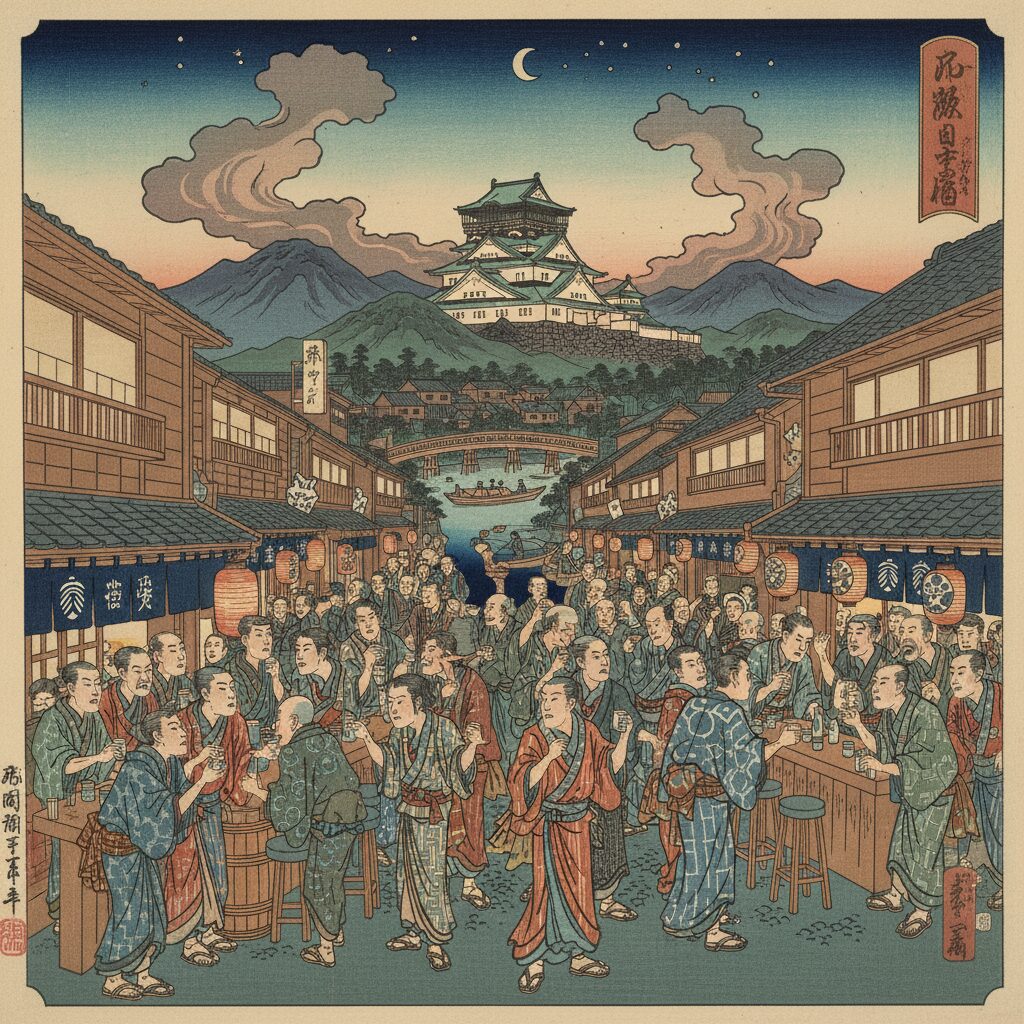
While the tachinomi are undoubtedly the main attraction after dark, the Kyobashi area boasts its own distinct charm during the day. The shopping arcades, which transform into vibrant corridors of nightlife at night, serve as lively centers of local trade by day. Here, you’ll discover family-run tea shops, stores selling ‘tsukemono’ (Japanese pickles), and traditional sweet shops. It’s a delightful area to simply stroll through and take in the rhythms of daily life. A standout landmark in the area is the Kyobashi Grand Chateau Building. This unmistakable piece of quirky Showa-era architecture is a multi-purpose entertainment complex resembling something from a retro science fiction movie. Its distinctive, castle-like spire is a cherished, if slightly kitschy, feature of the local skyline. For a change of scenery, a brief walk leads you to the banks of the Okawa River, a lovely stretch of greenery offering a tranquil break from the urban buzz. In spring, this spot becomes one of Osaka’s most breathtaking cherry blossom viewing locations, with hundreds of trees lining the riverbanks in a spectacular display of pink and white. A visit to nearby Osaka Castle Park makes an ideal start to an evening in Kyobashi. Spend the afternoon exploring the history and majesty of the castle, then as night falls, head to the standing bars, shifting from the era of shoguns and samurai to that of salarymen and sizzling skewers. This blend provides a wonderfully comprehensive glimpse of Osaka, connecting its grand historical past with its lively, everyday present.
A Toast to Authenticity
An evening spent in the tachinomi of Kyobashi is more than a mere culinary journey; it is a profound and meaningful cultural experience. It peels away the superficial layers of tourism and connects you directly to the vibrant pulse of Osaka. In a world growing increasingly homogenized, these small, unpretentious bars stand as bastions of authenticity. They are places where community is built over shared plates, where history is savored with every sip of sake, and where the simple act of standing together at a counter becomes a powerful form of connection. Kyobashi asks only that you be present. It invites you to listen to the rhythm of the Kansai dialect, to savor flavors perfected over generations, and to become, for a few hours, a small part of its nightly ritual. So, gather your courage, leave the well-worn path behind, and find an open spot at a worn wooden counter. Raise your glass, offer a ‘kanpai’ to the stranger beside you, and immerse yourself in the warm, chaotic, and utterly unforgettable world of Kyobashi. This is the real Osaka, ready to share its story with you.

